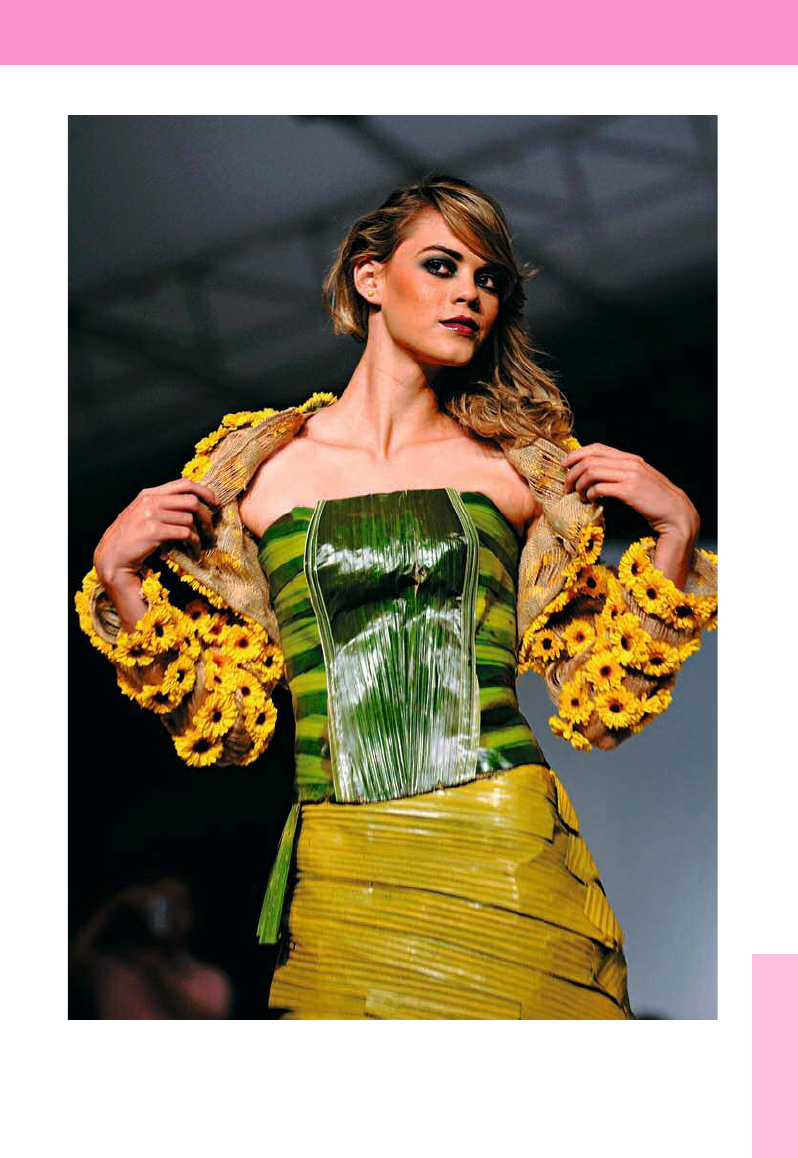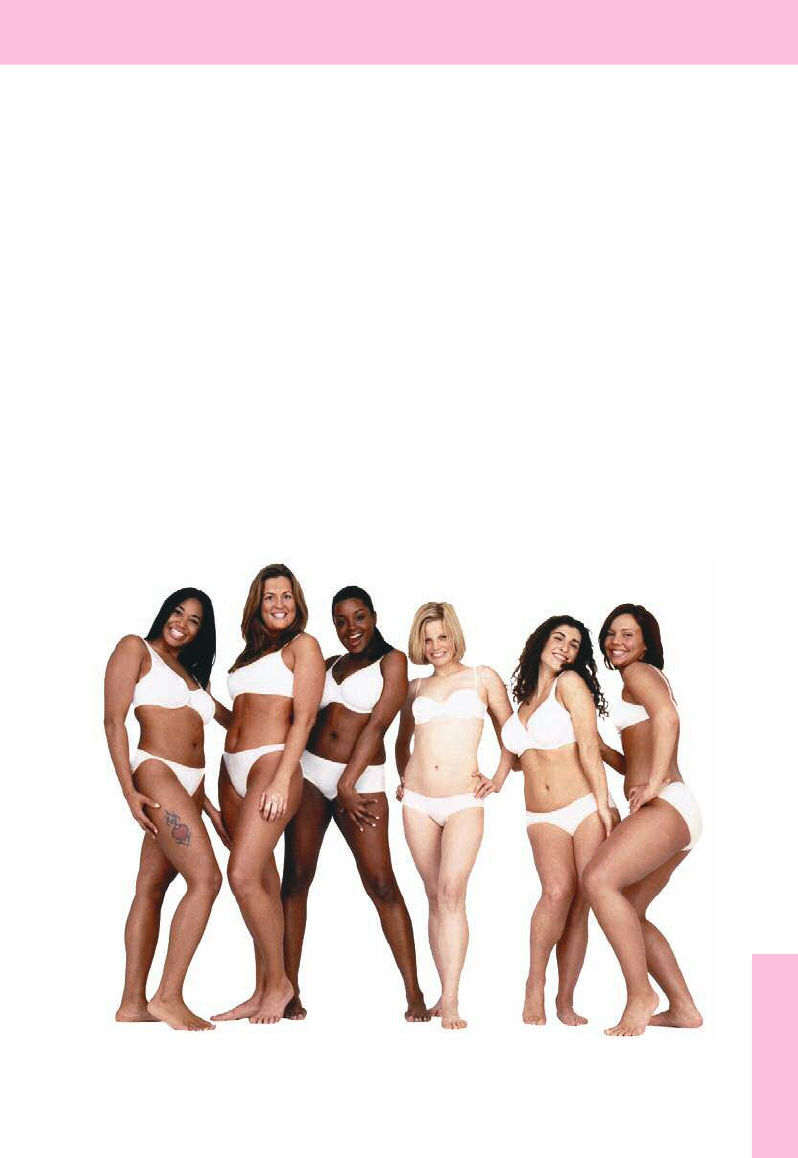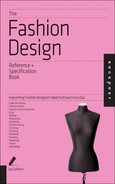
Job:02-30034 Title:RP-Fashion Design Ref and Spec Book
#175 Dtp:225 Page:248
248-255_30034.indd 248 2/27/13 6:38 PM
24 8 THE FASHION DESIGN REFERENCE + SPECIFICATION BOOK
(Text)
Chapter 25: Awareness
The world of fashion has begun to recognize many concerns that go beyond
perfecting the silhouette of a dress, giving rise to a new generation of con-
scious designers. Content as well as intent play into the designer’s creative
process and business strategy. Designers are asked to consider how their daily
operations and the imagery they produce affects the environment, fair trade
practices, self-esteem, cultural identity, intellectual property, and indeed, the
future well-being of their industry.
CONSCIOUS PRODUCTION
Green Design
Green fashion has come to mean something beyond clothing that is more statement than
style. Green thinking has become a natural extension of the design process. Leading design-
ers in the market are always ready to shift gears, to map out a place for themselves on the
new frontiers of fashion. They see the environmental concerns that have changed the way
fashion is approached as opportunities rather than difficulties, for they open up new markets
for designers and new kinds of products for the consumer.
The emphasis on organic pesticide-free fibers and production and delivery methods that
reduce environmental impact have created new specializations. For example, Massachusetts-
based Darn It! Inc. found their niche by helping to maintain the quality of products made over-
seas by correcting problems and finding solutions to warehousing and distributing goods.
Designers face environmental issues when debating the merits of local or overseas produc-
tion. Do they go overseas (for large-scale production and speed) or stay local (smaller produc-
tion runs with reduced environmental impact)? Re-examining the development of a product to
identify where processes can be modified to serve a greener standard will vary greatly based
on whether their work is exported or kept regional.
Fashion is based on conspicuous consumption and constant change. The designer of the
future will embrace alternative practices that still feed the hunger for what is current and excit-
ing. Fashion schools have begun to develop programming that addresses sustainability, gen-
erating a new kind of designer who repurposes garments, deconstructing and reassembling
them in creative ways to produce entirely new garments. These eco-friendly designers use old
clothing, remainders, closeouts, and overstocks—all goods that might otherwise end up in
a landfill.
Photograph by Luis Robayo/AFP/Getty Images.
25
Job:02-30034 Title:RP-Fashion Design Ref and Spec Book
#175 Dtp:225 Page:248
248-255_30034.indd 248 2/27/13 6:38 PM

Job:02-30034 Title:RP-Fashion Design Ref and Spec Book
#175 Dtp:225 Page:249
Book
e:248
248-255_30034.indd 249 2/27/13 6:38 PM
24 9
(Text)
-
-
t-
d
Pablo Cesar Dorado, Eco-friendly Design, Bio-Fashion Show, Cali, Colombia, 2008
Photograph by Luis Robayo/AFP/Getty Images.
25
Job:02-30034 Title:RP-Fashion Design Ref and Spec Book
#175 Dtp:225 Page:249
Book
e:248
248-255_30034.indd 249 2/27/13 6:38 PM

Job:02-30034 Title:RP-Fashion Design Ref and Spec Book
#175 Dtp:225 Page:250
248-255_30034.indd 250 2/27/13 6:38 PM
2 5 0 THE FASHION DESIGN REFERENCE + SPECIFICATION BOOK
(Text)
Fair Trade
Ethical fashion is produced under decent conditions for fair wages. Disadvantaged communi-
ties run the risk of being exploited, making third-party certifiers, for example, the Fair Trade
Federation and Transfair USA, necessary. A transparent supply chain will help to avoid sweat-
shop situations, with every step along the production path documented and information easily
accessed by everyone from the designer to the consumer.
Fair-trade safeguards also help to create sustainable economies for otherwise disenfran-
chised regions. They are a way for designers to connect with local artisans who would normally
not have a presence in the marketplace. Designers can also be instrumental in popularizing a
local product or service by adopting, protecting, and marketing it.
Those who labor to produce a designer’s product constitute the front line of fashion. Equitable
compensation is one more way a designer can do the right thing. In addition to earnings and
hours, many fair trade agreements ensure long-term commitments as well as investments in
the community, such as education and health initiatives.
Caring and Charity
“Animals are not ours to eat, wear, experiment on, or use for entertainment” is the slogan of
PETA, People for the Ethical Treatment of Animals. As it relates to fashion, animal-rights activ-
ism is concerned with the farming of animals for fur, the use of animals in entertainment, and
animal testing. Designers will need to decide to what degree they will embrace or reject the
implications of cruelty to animals for the sake of fashion.
The glamour and excitement of fashion has consistently drawn charities to designers as a way
to build awareness of and raise money for their cause. The Council of Fashion Designers of
America/CFDA Foundation has spearheaded campaigns and events such as Fashion Targets
Breast Cancer and Seventh on Sale (to benefit HIV/AIDS research). These are among the
most visible charities in the fashion industry, but education, poverty, hunger, and many other
causes are worthy beneficiaries. Giving back and showing that fashion cares is an important
part of designers’ relationship with the communities they serve. Designers might donate gar-
ments for auctions or put on lavish high-ticket fashion shows to benefit their charity of choice.
PROJECTED IMAGES
Sense of Self
Faces with character and bodies with curves need not fall under the category of fashion flaws.
How far has fashion gone when perpetual dieting and plastic surgery remain the only ways to
achieve the latest ideal of beauty? Nor should age be relegated to a second tier in the fashion
hierarchy. The boomer generation represents a gray glamour all its own. Living longer today
also means living better, resulting in vibrant and vital lifestyles—something that designers are
in an ideal position to amplify.
It
c
o
o
e
p
m
ti
T
ch
at
s
a
h
T
th
w
sa
b
25
Job:02-30034 Title:RP-Fashion Design Ref and Spec Book
#175 Dtp:225 Page:250
248-255_30034.indd 250 2/27/13 6:38 PM

Job:02-30034 Title:RP-Fashion Design Ref and Spec Book
#175 Dtp:225 Page:251
Book
e:250
248-255_30034.indd 251 2/27/13 6:38 PM
Awareness 2 51
(Text)
y
ly
a
e
-
d
y
.
.
n
e
It can be argued that adhering to established standards of beauty (however arbitrary) can
contribute to personal and professional success. But when these standards are distorted or
out of step with the society that is embracing them, its members are susceptible to poor self-
esteem, depression, body dysmorphic disorder, anorexia/bulimia nervosa, or any number of
physical and psychological complications that relate to a false self-image. Fashion designers
must realize that, one way or another, they are helping to perpetuate or prevent these destruc-
tive patterns.
The French fashion industry, supported by the French Minister of Health, has introduced a
charter of good conduct that encourages the use of models with diverse body types, in an
attempt to avoid potentially dangerous influences on young women. Promoting healthy body
sizes instead of idealizing unhealthy ones builds healthier body images. Spain and Italy have
also taken steps to ban from fashion shows models whose Body Mass Index falls below the
healthy range (18.5–24.9, as classified by the World Health Organization).
The Dove Campaign for Real Beauty is based on awareness and action. Leading by example,
the company has produced advertising and programming designed to educate and empower
women of all ages, body types, and ethnicities. Integrating all types of beauty sends a mes-
sage of acceptance to the consumer as well as a challenge to the rest of the fashion and
beauty industry.
Ad from Dove Campaign for Real Beauty
Photograph courtesy of DOVE)/Unilever.
25
Job:02-30034 Title:RP-Fashion Design Ref and Spec Book
#175 Dtp:225 Page:251
Book
e:250
248-255_30034.indd 251 2/27/13 6:38 PM

Job:02-30034 Title:RP-Fashion Design Ref and Spec Book
#175 Dtp:225 Page:252
248-255_30034.indd 252 2/27/13 6:38 PM
2 5 2 THE FASHION DESIGN REFERENCE + SPECIFICATION BOOK
(Text)
Cultural Identity
People from every corner of the globe buy into fashion, and yet there is a disproportionate
representation of different ethnicities and body types in the design field as well as among
the models on the runways and in the pages of fashion magazines. The perpetuation of a nar-
row definition of beauty contributes to racial bias. Moreover, the bottom line has advertisers
crafting very culture-specific images designed to harness a particular purchasing power. But
how can the fashion industry in the twenty-first century justify this imbalance? As the public
becomes more aware of the issue, they realize that if they are being asked to invest in the
products, they are entitled to see themselves represented in the fashion ads, in the editorials,
and on the catwalks.
Whatever their background, designers can address the fact that the exclusion of models of
color limits the potential of fashion. A precedent was set in 2008 when CFDA president Diane
von Furstenberg reached out to designers in an effort to encourage them to be diverse in their
runway presentations, although many of the shows remained whitewashed. This is not an
argument for enforcing multicultural quotas. What is important is that designers expose them-
selves to many different cultures and recognize that their business is supported by a range of
racial backgrounds.
Former model and agency owner Bethann Hardison has initiated a public discussion about the
relationship between black models and the fashion industry. History shows that black models
have made names for themselves. Dorothea Towles launched her modeling career in the early
1950s working for Christian Dior, Elsa Schiaparelli, and Pierre Balmain. Helen Williams was
the first prominent black model in the United States in the 1960s. Mounia was the first black
model on the Yves Saint Laurent runway. Naomi Sims appeared on the cover of Life magazine
in 1969, accompanying an article about new black models. Beverly Johnson was the first black
model to appear of the cover of Vogue, in August 1974. Pat Cleveland became a 1970s super-
model and muse to designer Stephen Burrows. Iman appeared in Vogue in 1976, her first job.
More recently, Veronica Webb, Naomi Campbell, Tyra Banks, Alek Wek, and Jourdan Dunn have
all had a strong presence. Observing the dates associated with each model, though, the ques-
tion becomes, Does the industry believe there is only room for one model of color at a time?
The current wave of Brazilian models, which include Gisele Bündchen, Adriana Lima, and
Alessandra Ambrosio, has taken fashion by storm. Yet they represent only a small fraction of
Hispanic beauty when one considers how diverse those origins are: European (Spain), Central
American (Belize, Costa Rica, El Salvador, Guatemala, Honduras, Nicaragua, Panama), South
America (Argentina, Brazil, Bolivia, Chile, Colombia, Ecuador, Paraguay, Peru, Uruguay, Ven-
ezuela), Caribbean (Cuba, Dominican Republic, Puerto Rico), North America (Mexico, United
States), Africa (Equatorial Guinea), and Oceania (Easter Island). Asian models have a very low
profile in fashion, but the number of new faces is growing: Devon Aoki (Japanese-American),
Han Jin (Korean), Yoon Sun Kim (Korea), Lakshmi Menon (Indian), Hye Rim Park (Korean-
American), Ling Tan (Malaysian), and Ai Tominaga (Japanese). The launch of Vogue China has
contributed to the growing awareness of Chinese models, including Xiaoyi Dai, Du Juan, Emma
Pei, Audrey Quock, Mo Wandan, Liu Wen, and Sonny Zhou.
D
Photograph by Andrew H. Walker/Getty Images for IMG.
A
D
H
C
M
C
P
O
N
A
I
L
25
Job:02-30034 Title:RP-Fashion Design Ref and Spec Book
#175 Dtp:225 Page:252
248-255_30034.indd 252 2/27/13 6:38 PM
..................Content has been hidden....................
You can't read the all page of ebook, please click here login for view all page.
